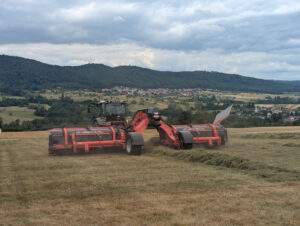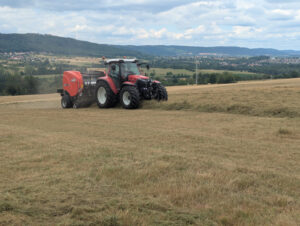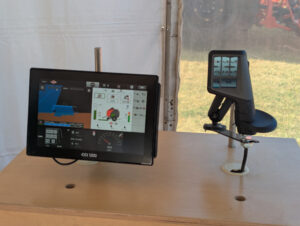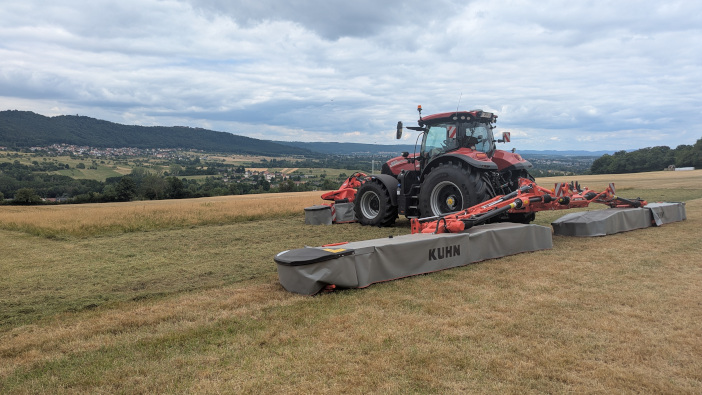Product updates and new models from the Kuhn Farm Machinery camp tend to come in a wave, and this year was no different as the company looks ahead to Agritechnica
There was a cautious optimism to the address given by Thierry Krier, CEO and president of Kuhn Group, at the start of the event. He acknowledged the various challenges facing farming on a global scale, as well as the fact that European farmers will likely be in a similar situation to those in the UK, with government support based on objectives rather than land mass.
He also noted that the market recession that we’d seen since the post-Covid pandemic recovery was likely far worse than the figures currently showed. The positive? He believes we are now coming out of the other end of it.
“We’re now seeing inventory moving on from dealer yards and our focus is on developing new products and technologies that will increase output with less labour,” he said. “With this, we’re becoming closer to end users, offering new services and highly configurable machinery to suit all situations.”
This ability to configure machines means that Kuhn, according to Thierry, can create about 60,000 unique models from 1,500 base machines within its portfolio.
Rolf Schneider, head of sales and marketing, expanded on these points, noting that about 40% of the total business now came from high-capacity machines designed for the largest farms. “We’re now looking at direct drilling solutions up to 8m wide, as well as shallow cultivation technology and weeding solutions,” he said.
He added that about €50m had been invested into research and development last year, with much of this focused on the company’s autonomous solutions. “The KARL autonomous machine stands as our most expensive project ever, while the Aura robotic livestock feeder is our second most expensive.”
The Aura has now come out of pre-series testing, with the first models outside of France set for release next year. Offering a 3cu m capacity and suitable for herds up to 280 head, the machine is set to enter the UK market in the second phase of release – likely 2028.
For the KARL unit, timings were a little less clear. Rolf noted that Kuhn was not a start-up and could not afford to release products that were still in development. “New processes are being added to the KARL product, but this will not be released until it is 100% ready for market.”
Dropping grass
Some of the biggest news from the event came from the company’s grassland portfolio. Sitting at the top of this, quite literally, was the launch of the GMD 15030, said to be the largest mounted mower on the market.
Offering a 14.5m working width when matched with a 3.1m front mower, it is constructed with four OptiDisc Elite cutterbars, each of which are mounted with seven discs. These feature the Fast-Fit knife change system. Key to the design is a patented gearbox, one of which is integrated into the frame on each, with a dual output to transfer power between the two cutterbars.
The cutterbars have an articulated connection that enables the machine to follow ground contours and comes with a non-stop breakback system to move past obstacles in the field. Control systems vary from the simple KFA 12 control box, all the way up to a full Isobus connection.
Crucially, the GMD 15030 is offered with no conditioner or merger, keeping the weight down at 3.8t, enabling it to be lifted and powered with about 230hp. For transport, the outer mowers fold through 180deg to sit on top of the centre units. This keeps the overall width under 3m and the height under 4m.
Less suited to UK conditions, but a machine that may find some interest from those working in wholecrop, the GMD 9530 RV mower has an adjustable working width from 9.1m up to 9.5m, depending on the overlap and front mower. In place of a conditioning unit or a belt merger, the 9530 RV is mounted with a 500mm-diameter auger, which runs at 900rpm.
The company says this is suited to high-yielding forage crops of up to 30t/ha, although it is unclear how it will handle the wetter silage crops over here. The auger is protected with a Cam clutch and shearbolt in the case of blockages and can be set to produce a swath between 1.6m and 2.2m wide.
 Swathing technology
Swathing technology
Updates were also announced for Kuhn’s Merge Maxx belt swather range. The new 102 product series has four models: the 762 has an adjustable working width from 5.5m up to 7.5m and is a non-Isobus unit. The 952 runs from 7.5m up to 9.5m, with the choice to specify it as an Isobus unit, while the flagship 1092 has a maximum working width of 10.95m and is only available with Isobus.
Those with Isobus control are offered with the company’s CCI 60, CCI 800, or CCI 1200 terminals for full control of adjustable functions from the cabin. These include the angle and position of the windguard roller; five ground pressure settings; the speed of the pick-up and belts; the working height; and a new pick-up without delivery function, which enables the machine to pick up crop from difficult-to-harvest areas and move it to a different swath.
A new angled tine has also been added, which the company says will improve the load-bearing capacity and pick-up performance. Maintenance adjustments have also been made, meaning that the cam can be accessed without disassembling the pickup.
Into the baler
 While it is unlikely to be picked up in the UK – although product specialist Rhodri Jenkins did say they would take orders if the interest was there – the new FB 3125 is designed for less-intensive users, producing about 2,500 bales a season.
While it is unlikely to be picked up in the UK – although product specialist Rhodri Jenkins did say they would take orders if the interest was there – the new FB 3125 is designed for less-intensive users, producing about 2,500 bales a season.
It’s a simple machine, using proven components from the Kuhn range. The 2.3m pick-up is complemented by the Integral Rotor system, and the bale chamber is the same 18-roller design as others in the range. It’s a non-Isobus machine, with the VT 30 terminal included to provide data on bale progress, intake, the number of bales and the number of net layers.
At the net application point, this isn’t available with film wrapping, but does include the Active Net stretch for consistent layering across the full width of the bale.
More advanced is the VB 7100 variable chamber series, which is the first on the market to be AEF certified for Isobus-controlled section control. This automatically lifts the pick-up at the field headland and drops it back into work at the next row.
It links to the Tractor Implement Management (TIM) system, which can also control forward speed and some steering functions to ensure that the pick-up is always full. It can geo-locate bales for the following tractor and trailer.
 It’s a neat system, and colours in the map to show progress, just as you would expect in a cultivation or drilling scenario. However, it will have to be overridden if parts of swathes are missed.
It’s a neat system, and colours in the map to show progress, just as you would expect in a cultivation or drilling scenario. However, it will have to be overridden if parts of swathes are missed.
Adding to this collection of data, from 2026, users will be able to specify the range with a weighing system on the kicker. Suitable for bales between 100kg and 1,500kg, the advantage of the kicker weighing system, according to Kuhn, is that it only weighs the bale, whereas integrated systems can be influenced by factors within the machine.
It will include a slope compensation sensor and data from the system will be sent to the in-cab terminal, with average bale weights, the weight of the last bale made and a total weight for contractors charging by the tonne. It can be used in combination with baler automation functions, including geolocation and data transfer, and can be used alongside moisture metrics to measure total dry matter yield.
The final baler update was for the VBP 7100 baler/wrapper combinations, with a new OptiCut 33 intake system. This has 33 knives and can provide a theoretical chop length of 34mm. According to Rhodri, while balers will never match the chop length of a forage harvester, this will provide better palatability for operators using round bale silage as part of the total mixed ration.
The knives can be run at different chop lengths, with the choice to activate 8, 16, 17 or the full 33 knives depending on the desired result. Each knife is individually mounted on a spring to protect it from foreign objects, and remains powered even when out of work. This means that during the automated cleaning process, all knives are lifted and cleaned for future-proofed performance.
The knife bank now pulls out of the side of the machine for easy access to ease changeover of the knives.



